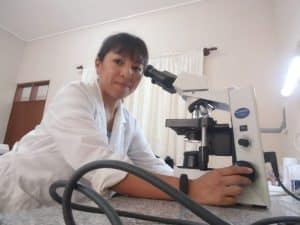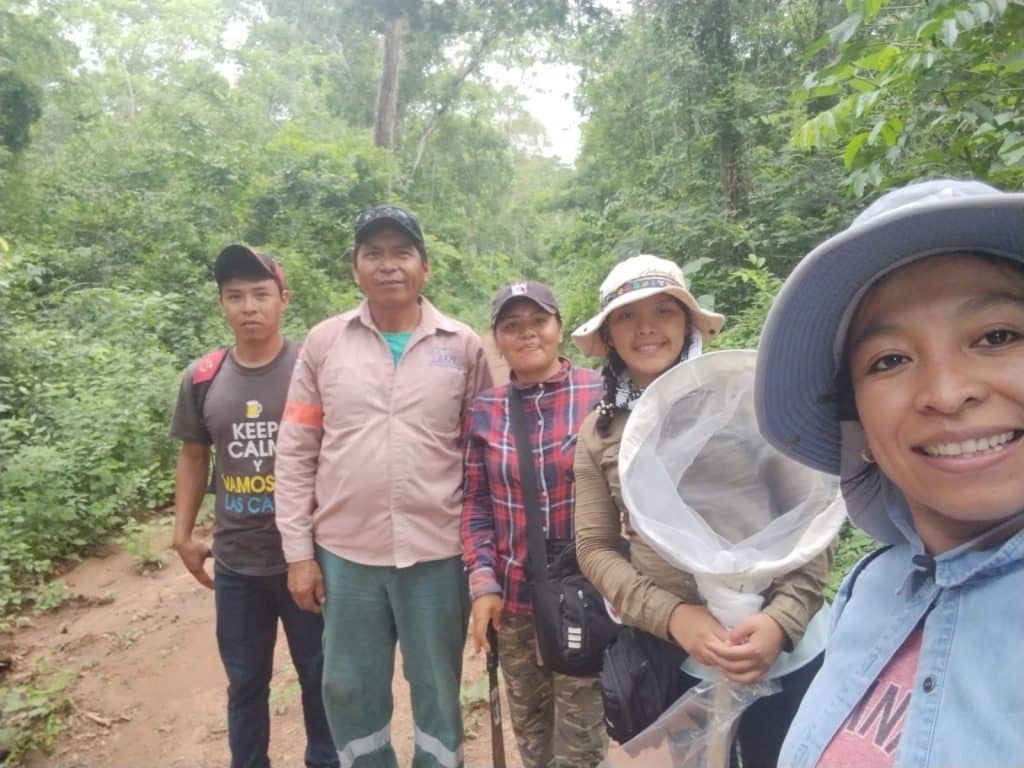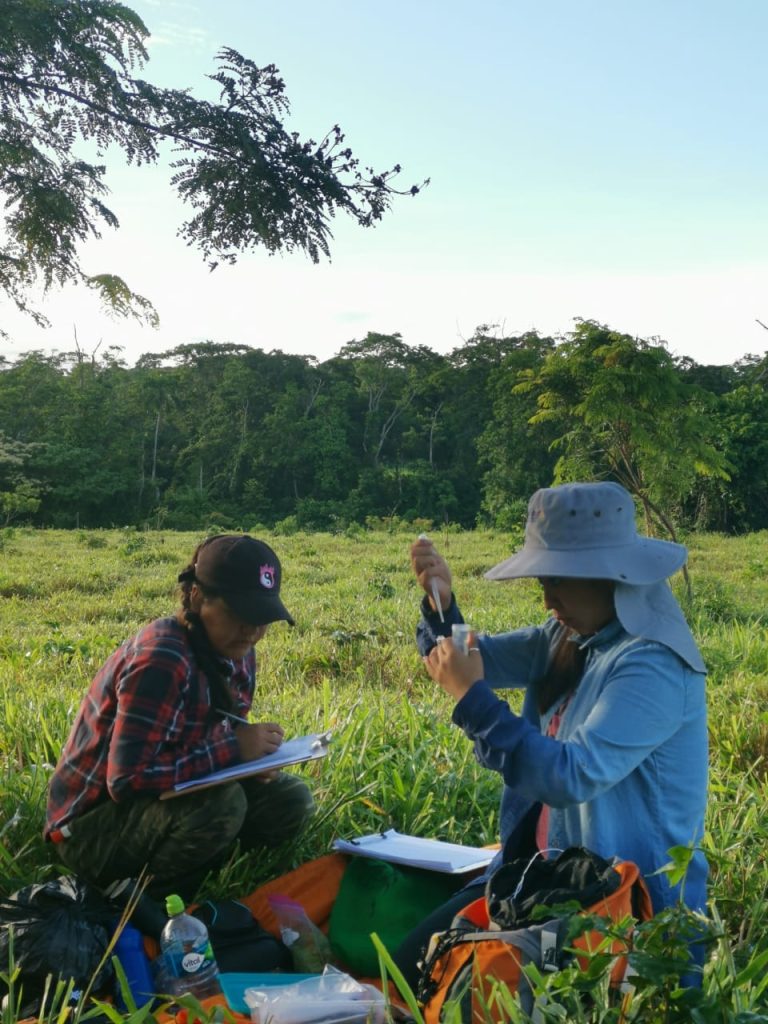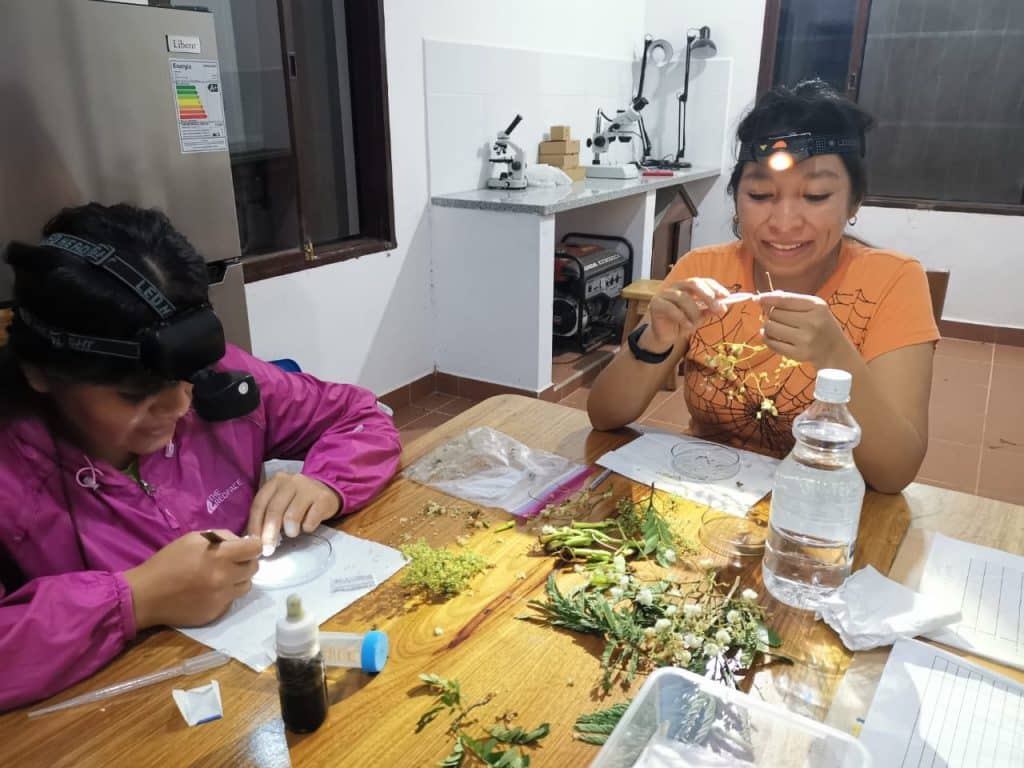An interview with Alexandria Saravia
Posted by Mariana De Niz, on 13 March 2023

MiniBio: Alexandria Saravia is an entomologist, microscopist and palynologist. She studied her undergraduate degree in Biology between La Paz and Santa Cruz. During her undergraduate degree she became involved in projects focusing on bee conservation and pollen analysis. She spent a year in Chile, at Universidad de Chile doing research, and in 2019 went to Mexico to Universidad Veracruzana, to do her MSc degree in Agriculural Sciences, with a hope of bringing together two separate fields: conservation/ habitat preservation, and agriculture. She’s a country’s expert in pollen, and uses microscopy to investigate, through pollen, the impact of ecosystem changes to bee survival, lifestyle, adaptation and spread.
What inspired you to become a scientist?
I am originally from La Paz, Bolivia, which is pretty much highlands, without a lot of vegetation in the city. La Paz is Bolivia’s capital city, with lots of buildings – very urban. But I still found the few plants that one can find there, very interesting. I always liked nature, and I would watch TV and see very green areas, jungles, forests, etc. which I had never known. It was then I realized I did not want to spend my career within the confines of an office. Afterwards while trying to discover what I wanted to do as a profession, I thought at first that the only way to become a scientist was by studying Medicine. I didn’t know that the career of Biologist existed. Once I became aware of it, this is what I enrolled for as an undergraduate. During the first semester of the degree I realized this is exactly what I was looking for! For me it was fascinating to belong to a “wild” natural world and make a living out of investigating this world. What inspired me to follow this path was also the passion of the researchers that taught us. They were these passionate individuals that wouldn’t mind crawling on the floor to catch an insect, or climbing a tree to grab a branch that was important to their work. I remember a foreign teacher who told us Biologists were special because they saw the world with different eyes – it was in one of her last classes as she was about to retire – I feel this was like life advice. I still remember her words, and I think I agree.
You have a career-long involvement in entomology, palynology, and microscopy. Can you tell us a bit about what inspired you to choose this path?
I studied Biology as an undergraduate in two locations: La Paz, and then Santa Cruz, Bolivia. During this time I specialized in entomology and palynology. It’s different to the macroscopic world, for example I had colleagues who studied jaguars, and would spend a lifetime waiting to find even traces – hair, faeces, or even just hear the animal’s roar. I don’t care much for working with animals and I specifically don’t like sacrificing animals for research. There was eventually a call for students to work on entomology. I applied and got accepted. A professor was looking for a field research assistant to work on bees. She needed the candidate to locate beehives in the mountains. I was selected for this work. It wasn’t easy at all at the beginning to locate them. We wanted to see the distribution of native bees, actually. I remember there were days in which I would look for a beehive for an entire day, and I would just find one or sometimes none. If I found one, I would sit there and observe the bees and the beehive in awe. I realized the bees were carrying yellow balls in their legs and I wondered what it was – pollen of course. I then wondered – what is it that these bees eat? These were Amazonian vegetation, and “chiquitana” (a region with the most hygrophilous forest on the banks and lowlands in the Santa Cruz department in southeast of Amboro Bolivia), and they are populated by 15-20 metre-tall trees. I couldn’t see very clearly what the bees would eat. So I went on to collect the pollen, to try and determine its origin. And this is when I came in contact with microscopy for the first time. I started researching about methodology and infrastructure to investigate pollen. Around 2015, there was only one palynologist in Bolivia (Dr. Teresa Ortuño), but at the time she was in Germany. So I contacted her and a few other people, and this is more or less how I got into the fields of entomology, palynology and microscopy. For microscopy, I started looking for protocols – but in Bolivia we don’t have a lot of access to reagents – it’s not as in developed countries where access is relatively simple. Here, there are a lot of restrictions. I tried to look for alternative, low-cost material for staining, and would sometimes arrive to the microscope and realize it hadn’t worked. It was a bit of a challenge and a lot of trial and error. Many substances often used for staining for microscopy, are highly regulated in Bolivia because some of them are used for illegal purposes like drug production. I was told from the beginning that in order to get hold of these substances, I couldn’t just order them myself – I had to make an official request to the university, and in order to get approval it would be a sea of bureaucracies. Still, I did everything I could and with the help of the university. Eventually I got hold of all my material, and by then I was desperate to give it a try! I remember at the beginning I used a technique from 1969 – nothing worked initially, so again it took a lot of optimization. The nice thing about microscopy is you can immediately tell whether it worked or not. Your eyes become well calibrated to know when a sample is perfectly prepared! Career-wise, after my undergraduate degree, I did a Masters degree in Agricultural Sciences. You might wonder why the change in fields: during my undergraduate, working with bees and palynology, I realized that there were serious problems related to agriculture, all within the same umbrella: habitat losses and conservation issues, resulting in loss of ecosystems and loss of bees. So for my MSc I decided to specialize in agricultural sciences. I wanted to know “from the inside” what was causing all the problems, and to know how agricultural scientists think about the problems brought about by agricultural practices such as extensive monocultures, and the use of chemicals, insecticides, etc, among other issues. I didn’t do a PhD yet. I did my MSc during the COVID-19 pandemic. I studied my MSc in Mexico (at Universidad Veracruzana), in the lab of Fernando Hernández Vaz y Mauricio Luna Rodríguez, but it was always my wish to come back to Bolivia, to pay back to my country in a way: to teach students what I have learned during my career, and contribute to the research done in my country. I haven’t ruled out doing a PhD, but we’ll see.

Can you tell us a bit about what you have found uniquely positive about becoming a researcher in Bolivia, from your education years?
I think it’s admirable that Bolivian scientists passionately contribute to the research and development of Bolivia. We do very unique research because it’s focused on regional issues. While one might wish to have more resources to do basic science, partly because of the limited resources devoted to research, we tend to prefer to research topics that address specific needs of the Bolivian community, generally. That’s why I’m trying to re-address the topic of palynology in the context of agriculture and conservation – to be able to use my work to help people directly. It motivates me to carry on as a researcher Regarding funding, Bolivia prioritizes applied science, and research that is directed towards community strengthening. Orchards and backyard gardens are examples of activities aimed at encouraging women involvement in community strengthening: these projects allow self-sustainability once completed. Despite the priority being applied science, I don’t forget that I’m a researcher, and that basic research is the basis of applied science in many cases. Regarding giving back to my community, I haven’t yet had the chance to do as much as I would like. I’ve given lectures in online courses, and I’ve worked together with agricultural scientists, coaching them when it comes to research design. I’ve also continued working with pollen, and many students seem to be interested, so I have supervised some students.
Can you tell us a bit about your day-to-day work?
When I’m in the field, it’s a different set of activities than when I’m in the city (in the lab). When I’m in the field, the day begins at 5am – the idea is to arrive before the bees do, and before they’re active – and as we all know, bees are “early birds”. So we have a quick breakfast and arrive to the site before the sun rises. We have a similar rhythm to the farmers who start working at 4am and pause at 8am when the sun has risen and it’s too strong to carry on. Anyway – we wake up and then hike for 3 or more hours to the sites of research. It’s important to remember to bring everything one needs for field work, otherwise, if one forgets anything (the camera, the bag, the tubes), it’s a several hours hike back….and back again. One has to be well prepared and well organized, mentally prepared. Sometimes we stay up to 20 days or 1 month on the sites – and then the real work begins. It’s important to have a ‘promotor’ or ‘matero’ as they are called in Bolivia. They are guides in the field. They help us and teach us, and we in return ¨teach¨ them all the research process: how to retrieve pollen, how we manage bees, how we recognize specific plants, it is a dialogue of knowledge, and so on – we end up becoming friends, spending so much time together. They’re very friendly and very helpful! In the lab, my work involves a lot of microscopy – it’s not easy to become an expert: we spend days on end looking at the samples collected and analysing them. I don’t have a defined schedule, but there’s always lots of work to do and one gets used to it. I like my job because it’s very versatile, and I find the skills I use in the field and in the lab very complementary.

Did you have many opportunities to interact with other Latin American groups, outside of Bolivia?
I did my MSc in Mexico. Before that, I was in Chile for a year. I went to Universidad de Chile, to the lab of Ecological Chemistry, and this allowed me to interact with Chilean researchers of course. I found the Chilean and Mexican researchers very different. In Chile they were doing mostly basic research, and I found that the pace is very different to the combined field/applied research pace. I was able to see two ways of working and learned a lot from both cultures and research styles. Regarding networking in general with Latin American countries, it’s a complicated topic – there’s a political agenda. Since some years ago, the entry of foreign NGOs (including some involved in research) to the country became restricted or even blocked. Many of those NGOs left Bolivia. Now collaboration is oftentimes facilitates to communication done remotely or by email. If something is needed regarding a collaboration, the foreign collaborators offer that Bolivian researchers go to their countries to do what’s missing, but one has to cover travel expenses so it’s very limiting, sometimes. It’s a pity that things have changed in such turn of events. I think foreign researchers were a valuable part of Bolivia’s research landscape, allowing for expertise, infrastructure and reagent exchange.
Who are your scientific role models (both Bolivian and foreign)?
I have several Bolivian role models – my mentors: Ariel Céspedes from Cochabamba, Carlos Pinto, Julieta Ledezma who are entomologists, Daniel Villarroel, Mercy Lopez, Mónica Moraes – all from the area of botanics. They publish a lot about palm trees. Rosa Leny Cuellar who is an ethnobiologist. All of them are researchers in Bolivia who have blazed their own way, many of them have completed PhD abroad and have come back to Bolivia to contribute to the development of the country. I sometimes wonder how they have achieved all this, and how they managed to remain perseverant and positive all along. Regarding foreigners, I spent some time in La Paz, where the degree of Biology was first founded in the country. There were European researchers who contributed to this first step including Stephan Beck, and others whom I found very inspiring too. They would use the University buses and would fill them with as many students as they could to give us the chance to do field work and make new discoveries in Bolivia. They were very passionate about their work and about teaching. Then there is Hermann Niemeyer, a Chilean scientist who was very disciplined – you had to be very punctual and use the right terms all the time. He set the bar very high for us (the students), and I found this very helpful throughout my career. Santiago Benitez, an Argentinian ecologist and entomologist, and Elia Ramírez, a Mexican palynologist – she taught me a lot and helped me complete my thesis throughout the COVID-19 pandemic. There are also other younger researchers, like Eliezer Cocoletzi from the area of statistics who also gave invaluable advice for my thesis.
What is your opinion on gender balance in Bolivia, given current initiatives in the country to address this important issue. How has this impacted your career?
Gender balance initiatives seem to be something gaining momentum nowadays. For instance now many calls demand a 50:50 ratio of men and women collaborating in projects. To be honest I never faced gender-based discrimination as a woman in my field. It’s a field where women participation is very high. I know, however, that other areas such as Zoology, have higher rates of discrimination. The work involves months of field work and a lot of physical strength, so they prefer men. Also in the nature of my work, we do a lot to involve women in communities – there we see a lot of gender imbalance: if a project starts, usually all the men are involved, but women are left at home as caregivers and caretakers. So in my case, the projects we bring to the communities are often specifically targeting women – to involve them as participants and leaders. And they have shown time and again to be extremely capable. It’s important though, in these projects never to act like it’s “them” and “us”. We are there to learn from one another and that’s the spirit of the projects.
Are there any historical events in Bolivia that you feel have impacted the research landscape of the country to this day?
Since 1952, Bolivia achieved universal suffrage, whereby everyone can vote. This had an important impact on research of course- the involvement of women in all professions. But comparative to some neighbouring countries, some had achieved universal suffrage since the 1800s, we’re lagging behind. All of a sudden this changed in Bolivia. I think since then, there are open doors to women, at least legally or officially speaking. Perhaps culturally, there are more limitations we still have to overcome.
Have you faced any challenges as a foreigner if you have worked outside Bolivia?
The main challenge is that when you go abroad you stop being “you” (i.e. I was no longer Alexandria), but I became “La Boliviana”. Then everyone expects something based on this – either for better or worse. So I feel I had to work very hard to show I was equally capable. This caused me a lot of stress, but I tried to do the best possible job. On the other hand, my immersion as a biologist into the agriculture world was difficult too. I would present my research proposal to the agricultural scientists and they would ask what the profit would be for them. It was a different way of thinking. I would reply that the benefits would not necessarily be monetary, but rather, ecological and conservational, and these achievements would not be immediate. I did this field transition in Mexico, so I was facing both challenges: changing fields and being in a foreign country. Although in Mexico I blended in in terms of features, as soon as I spoke, people could tell I was not Mexican. It’s difficult also to arrive to a foreign country all by yourself without knowing anyone or the system. I guess this is true wherever you go. I have the feeling that getting integrated in the agriculture team was easier than academia is sometimes, in terms of integration.
What is your favourite type of microscopy and why?
I’ve always worked with optical microscopy. My dream is to do SEM on pollen, but the cost is very high. In Bolivia, I know they have a SEM in Cochabamba, but they charge per hour of microscope use, so it can get very expensive. Moreover it would limit collaborative science in the country: since these microscopes are scarce, even if I did this type of imaging, it would be difficult to compare it with other findings from within the country unless those groups have the same availability. Maybe some day. But with light microscopy we can see the details we wish to see. Luckily we have a digital microscope in our lab, so it’s easy for me to quantify and measure. Light microscopy is easier to work with in terms of sample preparation, and the availability we have in the university.

What is the most extraordinary thing you have seen by microscopy? An eureka moment for you?
What I find fascinating is to see what bees carry with them in every new location. Different species of bees carry different things. And it’s fascinating to be the first person to see this in every new place. It’s very exciting for me to take field samples and then look down the microscope to see what story the pollen will tell. I imagine, just from the pollen, the type of forest in which the bees are living, what resources might be scarce, which ones are plentiful, and so on. We can tell a lot from these samples: the big picture. My general research question is ‘what are the food resources that bees use in a determined place’. Sometimes we make comparisons between specific locations: bees in places where monocultures (of maize, sorghum or soy) are common, and little intervened forests. We investigate whether in monocultures which use a lot of chemicals, bees then use sunflowers as sources of food, or if they travel a lot of kilometers away from food, we determine whether bees are actually adapting or if they prefer to migrate, or if they are suffering from this. We compare findings with natural reserves where there are specific interventions to prevent habitat damage. This is considering bees that are of the same species, so the findings can be huge and very interesting. The research is interesting but it’s still within a political and social context: to speak about soy, sorghum or maize monocultures, we need to compare two contexts: food security for human survival, and bee survival – of course one has more weight than the other, so it’s a delicate topic. Yet it’s a necessary topic to investigate.

What is an important piece of advice you would give to future Bolivian scientists? and especially those specializing as microscopists?
Be perseverant and disciplined. These overcome intelligence. If you quickly become dis-motivated when an experiment goes wrong, or when you can’t use a microscope the first time around, then it will be a tough path. When I was a student and wanted to use sophisticated microscopes or other pieces of equipment, I would have to wait half a day to be allowed to use it. Once the more senior scientists saw I was really perseverant they started respecting me more and giving me more freedom. Perhaps another suggestion would be that you buy yourself a small microscope so you always have access to your samples. Don’t get discouraged. Passion is very important.
Where do you see the future of science and microscopy heading over the next decade in Bolivia, and how do you hope to be part of this future?
I could give an optimistic view and a pessimistic one… Since 2015 until now I haven’t seen many changes in terms of microscopy infrastructure in Bolivia. Quite the contrary: I’ve seen the existing equipment more deteriorated than before. I hope I can contribute to change this. While we might not have the possibility to acquire new equipment due to limited funding, we can contribute to teaching a new generation of good and committed scientists. We don’t have a critical mass of researchers in many fields, like Anatomy or Polynology. I hope in a decade we will have a critical mass, and this will result in better infrastructure, better working conditions, and a bigger network. At the moment we are building in Santa Cruz the very first palinotheque (houses a collection of pollen) in the country. Hopefully in 10 years we won’t be talking about one but rather many in many regions around the country.
Beyond science, what do you think makes Bolivia a special place to visit and go to as a scientist?
The people! People are very warm and they are hardworking. I think this is common to all Latin American countries. Bolivia is super-diverse. We have different cultures, languages, food, many places to work. There’s a song that says that Bolivia “enchants” you – so, many foreigners keep coming back 🙂


 (1 votes, average: 1.00 out of 1)
(1 votes, average: 1.00 out of 1)